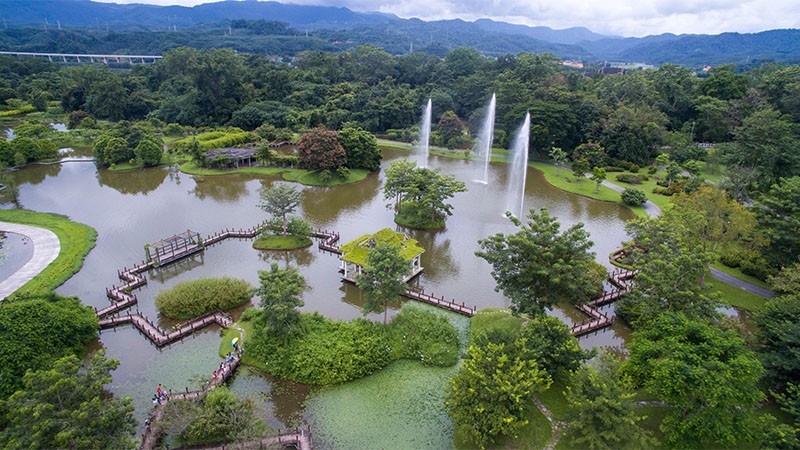
Alice Hughes explains what it is like to work in China and what the country is doing to help tackle the global problem of biodiversity loss.

Zoologist Alice Hughes leads the landscape-ecology research group at Xishuangbanna Tropical Botanical Garden in Menglun, Yunnan province, China.Credit: Michael C. Orr
British zoologist Alice Hughes has been working at the Xishuangbanna Tropical Botanical Garden in Menglun, Yunnan province, in southern China, for nearly eight years. She reveals what she has learnt about the country’s approach to ecological conservation ahead of its first United Nations biodiversity conference in Kunming, Yunnan, in May.
I lead the landscape-ecology research group at one of China’s most diverse botanical gardens. My team aims to better understand the lives of animals and how they interact with their environments. This helps us to create more effective methods of conserving a biodiverse environment.
The 18-person team, which is part of the Chinese Academy of Sciences (CAS), does everything from mapping biodiversity to researching the illegal and legal trade in different species, to find out where and why our natural world is changing. We then develop actionable measures to help stem the worst effects of those changes.
For example, many members of my team are working on the various species of Rhinolophus bats. Our genetic research suggests that around 70% of the Rhinolophus bat species haven’t been described in scientific literature. If you can’t describe a species, then you can’t conserve it.
In 2011, I moved to Thailand from the United Kingdom as part of my postdoctoral research, before heading to Australia and finally taking a position in China in 2013.
At first, I was naive about how different the culture might be in Asian countries and it’s definitely been a steep learning curve. Adaptability is important. I think that many people in the West are much too ready to disbelieve or find fault with actions from China, and Chinese scientists. As a result, there is sensitivity in China’s research community, especially around things that have frequently been an issue, such as the regulation of the trade of exotic wildlife. As a foreigner, it is a challenging balance to provide advice without it being seen as overly critical. I can participate in these discussions at a high level because I have worked here long enough: people know I will listen and provide my perspectives based on fact, rather than prejudice.
I’ve worked on some difficult and potentially sensitive topics, such as endangered species, wildlife trade and the Belt and Road Initiative, which aims to link global trade routes to China through international infrastructure development, for example. I focus on the possible impacts these might have on biodiversity and how to minimize them. China is wary of being accused of driving extensive biodiversity loss, especially as it is investing in scientific research to avert it.
I’ve been invited to join a variety of both central and regional government working groups. It’s a privilege to be in those groups and work with some of the country’s top scientists, especially when it comes to international or UN meetings.
Working for CAS is the equivalent to being an employee of the government. Many people outside China still find it surprising that foreigners work in scientific institutes here, even though the number is growing.
I’m also unusual because I’m a foreign woman. In the time I have worked here I don’t think I have met any other European women with full-time faculty positions in China. In my institute there are more than ten foreign men with such positions. It’s not easy for Chinese women either. At the institute, we have 43 research groups; only 3 are led by women.
It’s important for all conservation scientists to be open minded and willing to find out what’s going to work in any country and culture to help tackle the global problem of biodiversity loss, and develop solutions that work in that societal context. A good example of that came last year, when some specialists called for a global ban on wild-meat consumption, amid fears over new diseases that originate in wild animals and cause outbreaks in humans. Now that might sound like a great idea, but in many parts of Africa there is not enough water to raise livestock, and people depend on wild meat for food.
This means that rather than recommending a blanket ban, a better solution might be a system that monitors what is traded, and provides recommendations as to which species can be eaten safely and sustainably.

Xishuanganna tropical botanic garden in southwest China's Yunnan Province.Credit: Xinhua/eyevine
For most of my team, neither English nor Chinese is their first language. We have around 12 different nationalities, so discussions take place predominantly in English, as a default.
I work closely with my Chinese colleagues to make sure that our research work is properly communicated when it’s published in Chinese. In meetings with Chinese colleagues, someone will translate pertinent points to me, or I’ll translate my slides into Chinese and present in English. I also have my reports and briefs translated, and with advances in translation software, we can get what is needed done.
It’s easy to have misunderstandings when you’re translating ideas between different languages, so we’re careful to look for any linguistic nuances that might change the perceived meaning.
It’s an ongoing challenge. The concept of an ecological civilization — the government’s vision for environmentally sustainable growth in China — was written into the country’s constitution in 2018 after it was made a national priority in 2012, which is a huge commitment to sustainability.
A principal policy is the ecological conservation red-line plan, an idea that has been developed over the past decade. Across China, large areas of land are now being protected from industrial and urban development, in part to ensure that crucial ecosystems, such as wetlands that limit floods, can continue to function effectively. Multimillion-dollar developments have been torn down during its roll-out. China is one of few countries to have enacted such a science-based, top-down vision of how to balance human need with the maintenance of ecological services and preservation of biodiversity.
It’s not all perfect, though: I know that on paper, these ecological red lines now exist and in certain biodiversity hotspots they have been enforced. But not every region is the same. Areas have high levels of autonomy and in Yunnan, where I live, there have been more challenges for the local government to work with provincial governments for many practical and political reasons. The saying goes, ‘The mountains are high, and the emperor is far away’: places that are far away from Beijing feel less pressure to enact centralized policies because there is less supervision.
The south of China has seen lots of deforestation, which is hugely damaging to biodiversity. Natural forests have been replaced with for-profit tree plantations, usually planted with rubber or eucalyptus, which have had a hugely negative impact on biodiversity. Sustainable forestry is a real issue across Asia.
It’s the first time that China will host the UN biodiversity conference and this puts the spotlight on what they are doing to help the situation.
I know there are a number of senior Chinese officials who would like to see China take on more of an international leadership role, in addition to making efforts to preserve biodiversity domestically.
The current set of UN goals for global biodiversity expired last year and the next set, which is planned to be agreed at the convention, must encourage countries to plant diverse, native species. Currently, there is no pressure coming from politicians to do that, even though we know we suffer biodiversity loss as a result: we’re often hung up on targets, even if those targets are virtue signalling, rather than real change.
Also, governments tend to try to meet their targets in the easiest and most economically beneficial way. So they meet their tree-planting targets by planting by just a few, non-diverse species that are often not even native to the country.
We still need to include more practical goals in policy documents, such as enabling sustainable supply chains, to focus on the mechanisms behind biodiversity loss.
A Chinese ecologist needs to be fast to act. The time frame to submit an application for a grant can be very quick. Often you have less than 24 hours to respond. Also, most initiatives are tied to the government’s five-year plans, so our priorities need to adapt to reflect those five-year cycles.
In the past two years, there has been a complete inventory of all China’s marine and terrestrial protected areas so they can be accurately mapped and future targets can be based on them. That really is an unparalleled effort.
This involved mapping 400 marine protected areas, and 13,600 terrestrial ones. I haven’t heard of anything equivalent to this scale and speed in any other country.
The most positive thing for me is that science matters here. The annual budget for scientific research is increasing and the findings from our applied research inform national policy. That is something the West would do well to remember.
| Menglun, Mengla, Yunnan 666303, China. Copyright XTBG 2005-2011 Powered by XTBG Information Center |